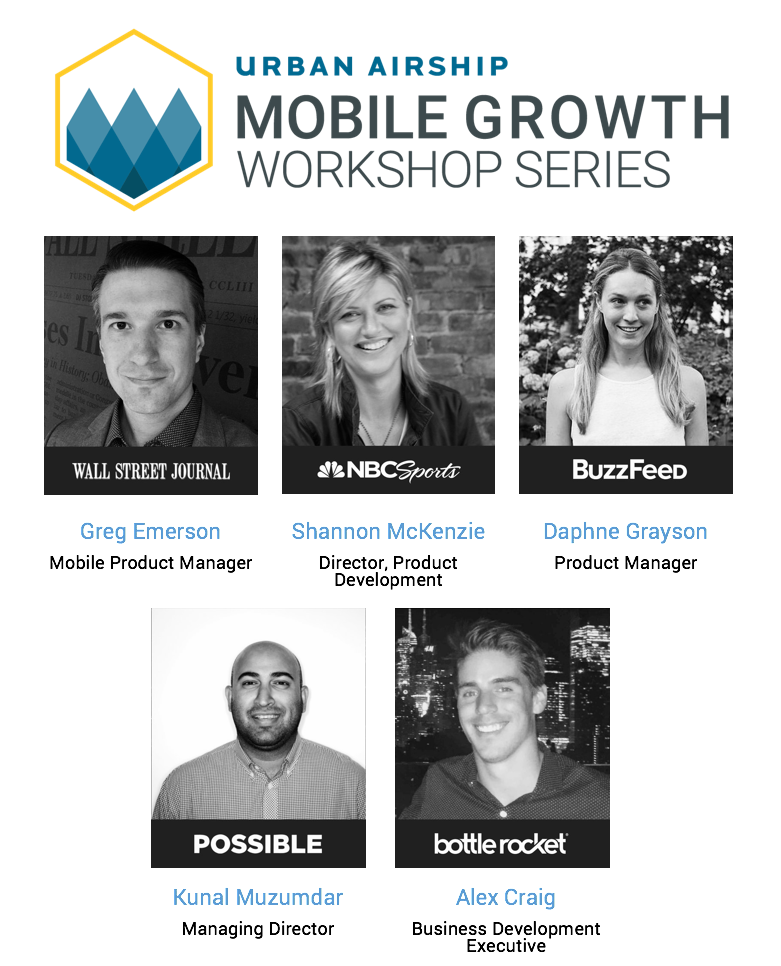
Connect With App Users, Tame Your Data, Personalization Best Practices & More: NYC Mobile Growth Workshop Recap
At our Mobile Growth Workshop event in New York City, mobile pros had the chance to connect with each other to discuss what’s working (and what’s not) in mobile marketing today.
As promised, we’re sharing a recap of the key insights from the event from attendees and from our guest speakers from Wall Street Journal, NBC Sports, BuzzFeed, POSSIBLE Mobile and Bottle Rocket.
1) Connect with your users on their terms — and in ways that help you meet your goals.
As consumers, we’re almost doing several things simultaneously with lots of device jumping. What it means for your user to “engage” with your app changes moment to moment based on their interest, needs and goals in the moment.
Key Insights:
-
“Engagement is different for each user and defined by each user. We monetize based on how often people get into the app, so the key is making notifications contextually relevant. With sports, it's about the peak emotional moment.” – Shannon McKenzie, Director, Product Development, NBC Sports
-
“Our news team works hard to make sure that the messages in a push notification are complete, and so users may not click through to open the app. That's why retention overall is a more important metric to us vs individual message engagement. But the goal still is to drive people into the app.” – Daphne Grayson, Product Manager, BuzzFeed
-
“”Engagement’ is a big goal — it can be too big. You need to zoom in on exactly what engagement means for your organization and your customers.” – Alyssa Meritt, Head of Strategic Consulting, Urban Airship
-
“In a subscription based business, engagement is great. But it needs to lead to paying customers.” – Greg Emerson, Mobile Product Manager, Wall Street Journal
2) Don’t be a slave to your data.
Data is good. But don’t get lost in a sea of numbers. Make sure you're looking at your data in context — and look at only the data that matters most. Balance your data with user testing, feedback and good judgment.
Key Insights:
-
“Measure less! If you look at each KPI on your scorecard, what happens? Stop measuring the stuff that doesn’t drive any action, and put more effort into things that do drive action.” – Kunal Muzumdar, Managing Director, POSSIBLE Mobile
-
“You can get really granular and focused on the data, but it might not give you the information you really need. Our testing comes down to listening to the users.They'll come back if they had a good experience.” – Shannon McKenzie, Director, Product Development, NBC Sports
3) It’s critical to track app user paths — across platforms whenever possible.
End to end tracking makes it easier to follow user paths through your app. But, it’s still important to understand user journeys at a granular level. And the more “places” you can track (devices, in-store, etc.) the better. Getting to a unified multi-platform view of what leads people to buy is the holy grail.
Key Insights:
-
“To make sure we know when someone is ready to subscribe, it’s critical for us to track all of the steps within their journey. What we’re working on is getting an even broader view of that journey — across both our app and the web.” – Greg Emerson, Mobile Product Manager, Wall Street Journal
-
“A 360 view of the customer can feel like a pipe dream. You’ve got some mobile data here, some email data there — but you can join your data sources in Urban Airship to sync these various data sources.” – Alex Craig, Business Development Executive, Bottle Rocket
-
“With multiple apps and multiple locations, trying to track users is hard. There’s device fragmentation, different UIs, content looks different in different places: it can be intense.” – Shannon McKenzie, Director, Product Development, NBC Sports
4) Focus on delivering unique value to your app users.
Figure out how to make your app really valuable for users — and communicate that value in a powerful way — and you’ll build loyal users who will not only keep your app, but promote it to others.
Key Insights:
-
“The biggest mistake we see is not understanding the core value proposition for an app. With 2.5 million apps in the app store, ‘if you build it they will come’ is not a valid strategy. You’ve got to be smart about how you promote it — and today, it’s about 50 build /50 marketing in terms of of app success.” – Alex Craig, Business Development Executive, Bottle Rocket
Use Case: Chik-fil-A promoted their app in every communication channel they had with a simple value prop: download the app, get a free sandwich. Within three days, they got 1 million downloads and top seller in App store. From there, they pivoted to the value prop of reducing time spent waiting in line with mobile ordering. It’s a powerful combination – who doesn’t want free food and shorter lines?
5) Personalization is good — when it creates a better customer experience.
When personalization is good, it’s good. When it’s bad it’s awful. Look at your personalization efforts from your customer’s point of view. If you’re early on in your sophistication level, you might consider holding off on more complicated personalization options until they a) require less effort on your part, and b) are reliably accurate, and c) are adding value to the customer experience.
Key Insights:
-
“Personalization is growing up slowly, into some level of knowledge that’s useful. The best way to start is by looking for ways personalization can make someone’s experience better. Calling them by their name is good; knowing the last article they read and suggesting another one they’ll like is better. Let the customer experience be your north star. Authenticity matters.” – Kunal Muzumdar, Managing Director, POSSIBLE Mobile
-
“Ask your customers what they want — in a preference center or elsewhere. Keep track of what they do in your app — and anywhere they engage with your brand — and bring together what you know so you can create an individualized, almost magical experience for them. That’s where personalization can really move the needle.” – Emily Buckman, Global Strategic Consultant, Urban Airship
6) Get comfortable guessing, learning and iterating. Don’t be afraid to make changes.
-
“There's a lot of energy toward trying to get to omni channel marketing. But not a whole lot of people doing it yet — and there's a lot of wasted effort. It's about some guessing, learning and iterating. Brands are paralyzing themselves because they're scared of not getting it right.” – Kunal Muzumdar, Managing Director, POSSIBLE Mobile
-
“It's really interesting to see what resonates and what doesn't. For example, in our push notifications, “Good morning” wins over any other kind of greeting in all our testing.” – Greg Emerson, Mobile Product Manager, Wall Street Journal
-
“Look for signals to better understand if the “job” the content is doing is achieved. If not, adjust.” – Daphne Grayson, Product Manager, BuzzFeed
For a front row seat at the next Mobile Growth Workshop near you, register today!
P.S. Can’t make it to any of the events? Subscribe to our blog so you’ll be sure to see our recaps. You can also follow us on Twitter and look for the hashtag #UAGrowth for live insights during each of the Workshops.
Subscribe for updates
If the form doesn't render correctly, kindly disable the ad blocker on your browser and refresh the page.
Related Posts


Don’t Miss Your Mobile Growth Opportunities


